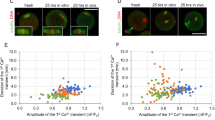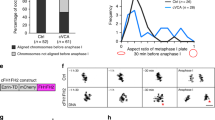Abstract
The parthenogenetic activation of mouse oocytes by several agents is accompanied by a large rise in the intracellular calcium concentration ([Ca2+]i)1. The tumour-promoting phorbol ester 12-O-tetradecanoyl phorbol acetate (TPA) activates some cellular processes which are also activated by raised [Ca2+] (ref. 2). We therefore tested TPA on mouse oocytes and found it to be a potent parthenogenetic activating agent. Recent reports suggest that TPA mimics endogenous diacylglycerol3 and can stimulate cells by activating protein kinase C without raising [Ca2+]i (refs 4, 5). We have now measured [Ca2+]i with aequorin in mouse oocytes treated with TPA. Sustained oscillations in [Ca2+]i appeared in those oocytes which were subsequently activated. We also measured [Ca2+]i during fertilization. The response began with [Ca2+]i transients as reported previously3, but the transients continued in a regular pattern for 4 h. There was no rise in [Ca2+]i of the type induced by activating agents such as ethanol. One component of the fertilization response appears to be related to the TPA-induced oscillations.
This is a preview of subscription content, access via your institution
Access options
Subscribe to this journal
Receive 51 print issues and online access
$199.00 per year
only $3.90 per issue
Buy this article
- Purchase on Springer Link
- Instant access to full article PDF
Prices may be subject to local taxes which are calculated during checkout
Similar content being viewed by others
References
Cuthbertson, K. S. R., Whittingham, D. G. & Cobbold, P. H. Nature 294, 754–757 (1981).
Durham, A. C. H. & Walton, J. M. Biosci. Rep. 2, 15–30 (1982).
Nishizuka, Y. Nature 308, 693–697 (1984).
Rink, T. J., Sanchez, A. & Hallam, T. J. Nature 305, 317–319 (1983).
Sha'afi, R. I. et al. Biochem. biophys. Res. Commun. 114, 638–645 (1983).
Cuthbertson, K. S. R. & Cobbold, P. Eur. J. Cell Biol. Suppl. 1, 14 (1983).
Whittingham, D. G. in Oxford Reviews in Reproductive Biology Vol. 2 (ed. Finn, C. A.) 205–231 (Oxford University Press, (1980).
Jafie, L. A., Sharp, A. P. & Wolf, D. P. Devl Biol. 96, 317–323 (1983).
Miyazaki, S. & Igusa, Y. Proc. natn. Acad. Sci. U.S.A. 79, 931–935 (1982).
McCulloh, D. H., Rexroad, C. E. & Levitan, H. Devl Biol. 95, 372–377 (1983).
Cuthbertson, K. S. R. J. exp. Zool. 226, 311–314 (1983).
Cobbold, P. H., Cuthbertson, K. S. R., Goyns, M. & Rice, V. J. Cell Sci. 61, 123–136 (1983).
Author information
Authors and Affiliations
Rights and permissions
About this article
Cite this article
Cuthbertson, K., Cobbold, P. Phorbol ester and sperm activate mouse oocytes by inducing sustained oscillations in cell Ca2+. Nature 316, 541–542 (1985). https://doi.org/10.1038/316541a0
Received:
Accepted:
Published:
Issue Date:
DOI: https://doi.org/10.1038/316541a0
This article is cited by
-
ASTL is mutated in female infertility
Human Genetics (2022)
-
Sperm-borne phospholipase C zeta-1 ensures monospermic fertilization in mice
Scientific Reports (2018)
-
Signal transduction in mammalian oocytes during fertilization
Cell and Tissue Research (2016)
-
Control of intracellular calcium bursting oscillations using method of self-organization
Nonlinear Dynamics (2012)
Comments
By submitting a comment you agree to abide by our Terms and Community Guidelines. If you find something abusive or that does not comply with our terms or guidelines please flag it as inappropriate.



